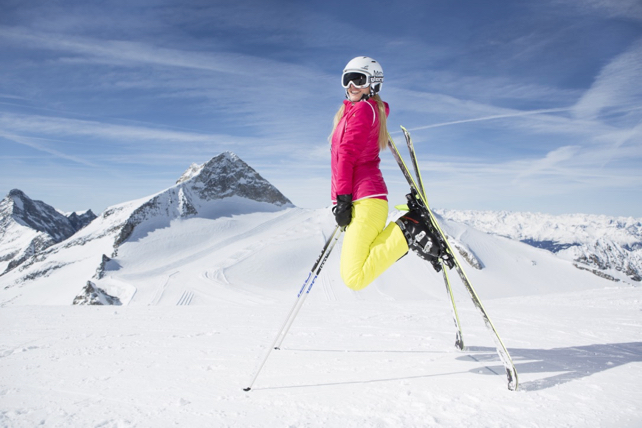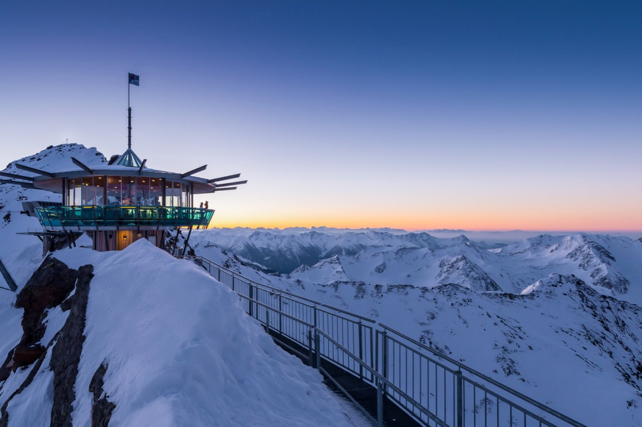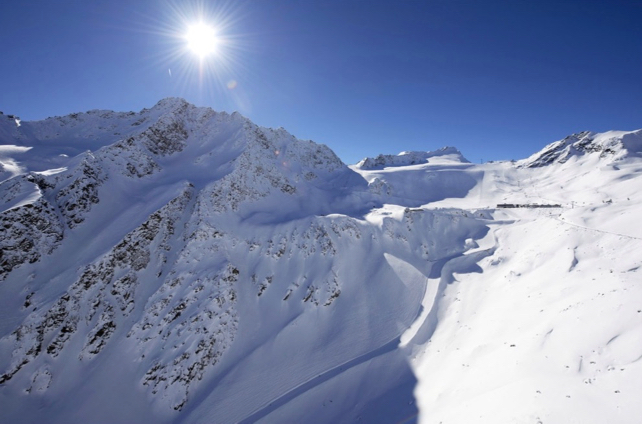
Ladies and Gentlemen, meine Damen und Herren, let’s hear it for spring skiing.
Because for those in the know, it’s one of the best moments of the entire season. Yes, down low the snow may be melting. Yes, down low the crocuses are out, and forests are warming up. You’ll smell their tangy, earthy resin every time you waft past on a chair lift. Up high, however, there’s still time for one last hurrah. The sun is blazing. The white stuff still lies deep: and if you know how to ski spring conditions, you can wring a unique and deeply satisfying experience from the slopes when everyone else is looking the other way.
Here are six resorts in the Austrian Tirol where you can celebrate this fleeting but brilliant moment: one that will have you buzzing all the way to summer.
Gurgl

When it comes to spring skiing, altitude is almost always your friend. So it’s good to know that in four separate places in Gurgl (home of Obergurgl and Hochgurgl) the lifts rise above the 2800m mark. In one, the Wormkogel II chair lift breaks the 3,000m barrier, and deposits you next to one of the most spectacular mountain restaurants in the Alps.
It’s called the Top Mountain Star – and it straddles a narrow band of rock, just off the main Alpine ridge: the rocky spine of mountains that runs right through the Alps and acts as a dividing line, not just between nations, but weather systems too. Stand on the Top Mountain Star’s viewing platform and you’ll swear you can see all the way to summer.
But before you break out your flip-flops, there are 112km of west and northwest-facing slopes to ski. Most are marked blue and red on the piste map: and range from the kind of long, broad and gentle runs that more hesitant skiers will love, to more challenging straight-down-the-mountain descents. If snow conditions are good, there are plenty of off-piste and ski-touring routes too: and more of the same on offer a little lower down the Ötztal at neighbouring Sölden (see below). You can ski both resorts on the same Ötztal Super Skipass.
Meanwhile, back at base, well-equipped family-friendly hotels beckon, with indoor pools perfect for a family splash once ski school is over. Lessons don’t start till 10am, by the way. Which gives you the perfect excuse each morning to have a lie-in – wiggling your toes and feeling smug about your choice of Easter skiing resort.
Hintertux

For snow-starved skiers, at either the beginning or the end of the season, there are few better feelings than piling out of the top lift at Hintertux. There you are, at the eye-watering altitude of 3,250m; and whether it’s April, May or early October you’ll find a world of white on its twin glaciers, the Gefrorene-Wand, and the Riepenkees. (In fact, you can ski there all year.)
The reaction, just outside the Gletscherbus lift station, is usually the same. Gasps of wonder are followed by a rush of excitement as everyone fumbles with goggles, gloves and ski bindings in a bid to get skiing as quickly as possible. Then, after a few exuberant turns someone stops. In part, that’s because they’ve got a bit of a headspin: the lack of oxygen in the high-altitude air takes some getting used to. In part, it’s because they need to readjust to the slope. It’s a lot steeper than they were expecting from a glacier.
And suddenly everyone understands why the ski racers of the world come to Hintertux to train. If you like your skiing fast and challenging there’s no better lift-serviced slope in the Alps than this.

That said, most of 60km of the pistes here are gentler – including those on the Riepenkees glacier opposite that first steepish run. Most are above the 2500m mark too and are properly north-facing too. For keen intermediates they add up to one of the loveliest places to ski when the snow is either non-existent or slushy elsewhere. Book tuition with the Tuxertal Ski School to add to the thrill: this is the perfect place to work on perfecting our turns on steeper pistes. Or why not try your hand at gate-skiing, just like a Giant Slalom skier? There’s no better way to turn an afternoon on a single piste into a bright, white thrill.
Meanwhile, in the valley below lots of good hotels beckon. Those in the hamlet next to the Gletscher Talstation (the valley station for the lifts) are the most convenient. But if you want to mix your wintry glacier snow with a tantalising taste of spring, consider staying in one of the lower villages, such as Lanersbach. Here, you can finish your day with a forest walk, or maybe a swim on your hotel’s rooftop pool.
Sölden

Thanks to its two glaciers, Sölden is one of the first big ski resorts to get going at the start of winter: and one of the last to stop. At the end of October it hosts the first ski race of the FIS World Cup: and in April it’s the setting for the Electric Mountain, a big outdoor dance-fest driven by DJ sets from the likes of David Guetta and Afrojack. The lifts usually shut at the beginning of May.
Meanwhile, in between those dates you’ll find a respectable 144km area of broad, come-hither pistes with challenges at every level: from the plunging World Cup course on the Rettenbach glacier to the grippy, confidence-boosting cruisers of the Tiefenbach, on the other side of the Innere Schwarze Schneid.

Most of the skiing is above the 2,000m, with the lift system breaking the 3,000m barrier in several places: and with the pistes generally facing northeast, they hold their snow well. They’re exceptionally broad too. Sölden claims the average width is a massive 30m (about the same as both sides of a three-lane British motorway).
In other words, this is a big, high-altitude offering for a single resort – especially when you factor in the Area 47 snowpark and its many off-piste routes. And if you do get bored, then you can always catch a bus up to Gurgl (see above). It’s covered by the same ski pass.
But whereas Gurgl is a relaxing, family-oriented destination, Sölden is a buzzier, more adult-oriented place. In any normal season, you can flit between impromptu sun-deck dance parties at Hochsölden and suave lunches at Ice Q, the glittering glass restaurant set at 3000m. The restaurant even has its own wine – Pinot 3000, blended from wines made in Austria, Germany and the Südtirol.
Ischgl

Thanks to one of the world’s best snow-making systems, Ischgl always gets off to a good start each winter – and can replenish its cover later on if necessary. What’s more, its slopes range mostly between 2,200 and 2,800m and face north: so they hold their snow well as spring strengthens it grip. The resort also hosts outdoor concerts on the slopes.
That said, not all the slopes turn their backs to the sun. Some look south, towards the Swiss village of Samnaun: and the locals make good use of them on classic spring days. Alois Kurz, head of the Ischgl ski school, defines such conditions as when mild, sunny days are followed by nights when the temperature drops to -4 or -5C. In such a spell of weather, the cycle of mild-cold-mild temperatures creates a daily melting effect when the sun first hits the snow. If you ski a piste at just the right moment, you’ll find it has a surface like velvet.
“We usually start by heading up the Flimjochbahn,” says Kurz. “There the south-facing pistes might still be hard at 9am. But my 9.30am they can be perfect.” In other words, the top 1-2cm of snow will be soft, but everything underneath will still be hard. The result is a surface that’s firm, smooth and grippy.
“After that, we move around the ski area, following the sun,” says Kurz, “finishing on the north-facing runs.” Then, the terrace at the Bergrestaurant Alpenhaus beckons for a long, late lunch.
Stubai Glacier

Fancy a little city with your late-season snow? Then book a long weekend in Innsbruck. The Tirolean capital is ringed with mountains: but what makes it special come late March and April is its proximity to the Stubai Alps. Part of the main Alpine ridge, this chunky, snow-drenched massif tops out at 3,507m; and it’s home to one of the most enjoyable high-altitude ski areas for intermediates in the Alps – the Stubai Glacier.
All in all there are 65km of pistes to ski here, most of them north or northeast-facing, and most set between 2,600m and the top lift station at 3,210. But it’s not just the extent of the high-altitude skiing that’s impressive. It’s the steady, come-hither gradient of the slopes. Add the benign effect of the soft, reliable snow, and you’ve got a place that’s all but guaranteed to boost your confidence. Ski it on weekday, when everyone else is at work, and the effect is even more memorable. You’ll carve turn after turn after smooth, joyful turn until your legs explode. Especially if the 10km descent all the way down to the Mutterberg valley station is open.
Accommodation at the bottom of the lift system is limited. Most visitors stay in the pretty, well-developed tourist village of Neustift. But for a really distinctive experience, why not book into Innsbruck itself, and drive up to the Stubai valley each day? Art galleries, chic restaurants, Sachertorte chocolate cake, student bars, Hapsburg palaces: if you fancy a change from the usual ski-resort scene, this is where to find it.
Pitztal Glacier

Welcome to the highest lift-serviced skiing in Austria. At the Pitztal Glacier, the Wildspitzbahn cable car whisks you up to a magnificent 3,440m, from which point a small but highly-rated selection of pistes drops no lower than 2,688m. Most of the pistes face north-east too. If you want the best possible chance of skiing soft, wintry snow in an Austrian spring, this is where to find it.
They serve great cakes at the top-of-the-mountain Café 3.440 too. Jutting out from the side of a crag, it offers goose-bump views towards Austria’s second-highest mountain, the Wildspitze.
No wonder the painstaking German site skiresort.info has rated it a world-leading resort with up to 20km of slopes.
Lower down in the valley, you’ll find a second small area at Rifflsee – and between them the two networks offer 68km of pistes. If you’ve ever wondered what skiing is like away from the hustle and bustle of the big-name resorts, they’re a canny choice – especially if you’re holidaying for just a weekend or a short break.














Add Comment